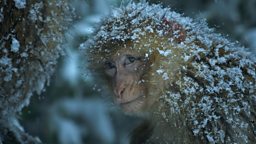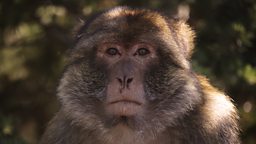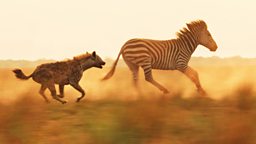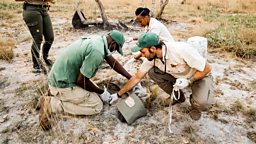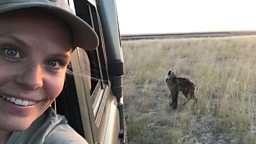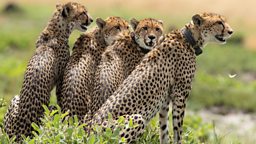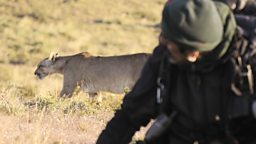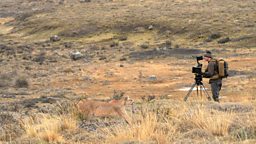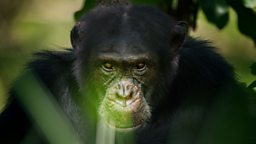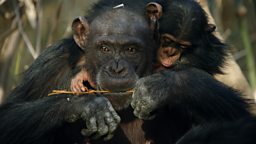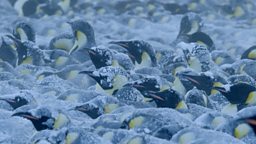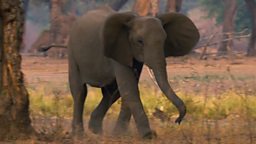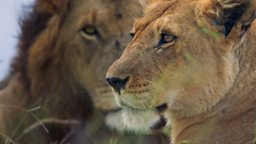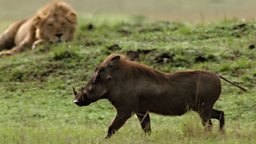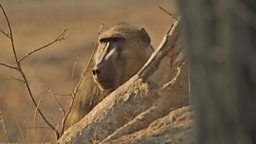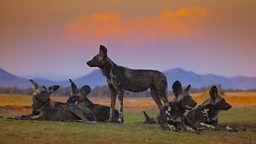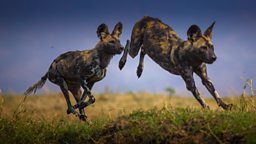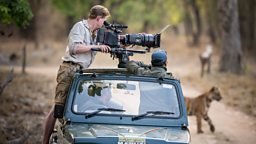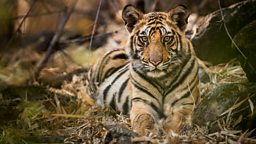The threat of snares
By Aaron Sandhu, Researcher for Hyena, Dynasties II

The days in Liuwa start early. By 5am, you are expected to have your vehicle loaded, your coffee cup full, and ready to head out. This is for good reason – by midday it can be as much as 38 degrees, and the intensity of the sun drives much of the wildlife into bushes or burrows looking for shade, so we have to make the most of the mornings.
Collars allow scientists to monitor populations
But this morning was slightly different – we knew that the scientists from the Zambian Carnivore Programme were planning to collar a Hyena from a nearby clan, so cinematographer Matt Blair and I were planning to spend the morning following them to film and understand their work better.
Collars allow scientists to monitor populations – by tracking one hyena fitted with a radio collar, there is the possibility they will lead the scientists to many others of their clan. The collars don’t harm the hyena, or influence their behaviour, and in some instances they can even help to save those under threat…

By 6.30am we had arrived at the den of the North Clan. As we approached the den, Daan – the project lead – leant out of the window to take an identification picture of a possible candidate for collaring. Something caught his eye. The young female he had hoped to collar had a metal wire looped around her throat, and it had pulled tight – she was the victim of a poacher’s snare. Somehow, she must have either pulled herself free or chewed through the wire tether of the snare – such is the strength of a hyena’s jaws – but she still had the metal noose digging into her neck.This switched the whole mood, and immediately the research team became rescuers.
This switched the whole mood, and immediately the research team became rescuers.
On top of what was already going on, an extra challenge was that the snared hyena was next to her clan’s communal den. This is a sensitive location for hyenas – it is their home, their central meeting point, the place for some mothers to give birth – to avoid distressing the others, the team had to be patient and wait for the snared hyena to move away from the den.
However, once she did move on, she headed straight into an area of long grass, with hidden obstacles… Just when the vet, Dr. Kambwiri Banda, was getting into position with a dart loaded, the hyena in his sights… BAM! A pothole. Thankfully though, a second vehicle was on hand – our filming car. Matt and our driver, John, worked quickly with the scientists to pull the vehicle out and the team were back on track.
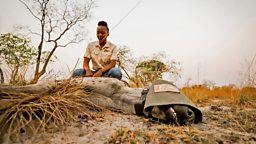
With the hyena finally in a good position, within range of Dr. Kambwiri’s dart gun, he pulled the trigger. A deft shot. There was now less than 10 minutes until the tranquilliser kicked in and the hyena became sedated. The team had to monitor her from a distance, and wait it out…
The ability for Hyena to heal from even horrendous wounds like these is incredible
When Dr. Kambwiri was satisfied that the hyena was fully sedated, the next phase began. Her eyes were covered, and with other team members taking measurements and recording vital signs, Daan and Dr. Kambwiri set to work removing the snare.
It was a horrific injury. Already centimetres into her neck, it was extraordinary that she had been moving around so freely. Working quickly but calmly the snare was removed and the wound cleaned, before Dr. Kambwiri administered a drug to reverse the sedation. Soon after the team withdrew, she was back on her feet, heading off to return to her clan.
The ability for Hyena to heal from even horrendous wounds like these is incredible, and she was likely to make a full recovery thanks to the efforts of the research team and park authorities.
Wire snares are indiscriminate and any living animal can get caught in one. Poachers aim to catch large herbivores, but carnivores can also get caught and often die in these illegal wire traps. Tracking collars are used not only for data collection to inform and direct anti-poaching patrols, but they also enable scientists to track individuals and groups, and rescue snared animals.
Since the start of the project, more than 80 large carnivores have been de-snared by the Zambian Carnivore Programme and this, combined with the efforts of other conservation groups and local authorities, has helped to limit the effects of illegal wire-snaring on carnivore populations in Zambia. Collaborative anti-snaring work has contributed to stabilising and even increasing carnivore populations in Zambia, including particular success with wild dogs in the Luangwa region.
